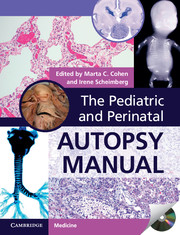Book contents
- Frontmatter
- Contents
- List of contributors
- Foreword
- Preface
- Acknowledgments
- 1 Perinatal autopsy, techniques, and classifications
- 2 Placental examination
- 3 The fetus less than 15 weeks gestation
- 4 Stillbirth and intrauterine growth restriction
- 5 Hydrops fetalis
- 6 Pathology of twinning and higher multiple pregnancy
- 7 Is this a syndrome? Patterns in genetic conditions
- 8 The metabolic disease autopsy
- 9 The abnormal heart
- 10 Central nervous system
- 11 Significant congenital abnormalities of the respiratory, digestive, and renal systems
- 12 Skeletal dysplasias
- 13 Congenital tumors
- 14 Complications of prematurity
- 15 Intrapartum and neonatal death
- 16 Sudden unexpected death in infancy
- 17 Infections and malnutrition
- 18 Role of MRI and radiology in post mortems
- 19 The forensic post mortem
- 20 Appendix tables
- Index
- References
6 - Pathology of twinning and higher multiple pregnancy
Published online by Cambridge University Press: 05 September 2014
- Frontmatter
- Contents
- List of contributors
- Foreword
- Preface
- Acknowledgments
- 1 Perinatal autopsy, techniques, and classifications
- 2 Placental examination
- 3 The fetus less than 15 weeks gestation
- 4 Stillbirth and intrauterine growth restriction
- 5 Hydrops fetalis
- 6 Pathology of twinning and higher multiple pregnancy
- 7 Is this a syndrome? Patterns in genetic conditions
- 8 The metabolic disease autopsy
- 9 The abnormal heart
- 10 Central nervous system
- 11 Significant congenital abnormalities of the respiratory, digestive, and renal systems
- 12 Skeletal dysplasias
- 13 Congenital tumors
- 14 Complications of prematurity
- 15 Intrapartum and neonatal death
- 16 Sudden unexpected death in infancy
- 17 Infections and malnutrition
- 18 Role of MRI and radiology in post mortems
- 19 The forensic post mortem
- 20 Appendix tables
- Index
- References
Summary
Introduction
Incidence of twins and higher multiples
Multiple pregnancy is not the normal situation in humans. Naturally conceived twins account for only 1% of pregnancies, while only 0.1% are triplets and higher multiples. Since the advent of assisted conception and in vitro fertilization (IVF) the rate of multiple pregnancies has increased substantially. In the UK the multiple pregnancy rate has increased from 9.6 per 1000 in 1976 to 15.7 per 1000 in 2010 [1]. In the United States the situation is similar, with an increase from 18.9 per 1000 in 1980 to 32 per 1000 in 2005 [2].
Types of multiple pregnancy (MZ/DZ) plus etiology
Multiple pregnancies may be derived from the same or separate fertilized ova. Approximately 28% of twins in Western countries are from a single ovum (monozygous) and result in identical twins, while 72% are from separate ova (dizygous), resulting in non-identical or fraternal twins. The rate of monozygotic twinning appears to be constant worldwide, whereas dizygous twinning is more common in Black Africans (1 in 24 pregnancies) and least common in those of Far Eastern origin (1 in 140 pregnancies) [3].
Monozygous twins are thought to arise as the result of a random event in the conceptus, leading to splitting of the early embryo into two halves. Occasionally it is thought that an abnormal clone arising in the early conceptus leads to splitting into twins. However, in general, monozygous twins appear to be genetically and physically identical.
Dizygous twinning shows a familial tendency, which is maternally inherited. Sisters of dizygous twins have a 2.5-fold increased rate of having dizygous twins [4]. Dizygous twins are also more common in older mothers [4].
Exogenous hormones given to enhance fertility are associated with multiple ovulations and thus multiple fertilized ova and dizygous twins. The vast majority of twins resulting from assisted conception (AC) and IVF are the result of implantation of more than one fertilized egg into the mother’s uterus. However, 0.8–5% of pregnancies following AC and IVF turn out to be monozygous, compared to the expected rate of 0.45% [5].
- Type
- Chapter
- Information
- The Pediatric and Perinatal Autopsy Manual , pp. 93 - 104Publisher: Cambridge University PressPrint publication year: 2000



